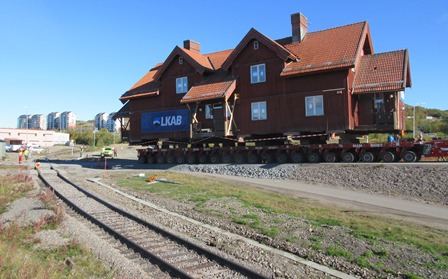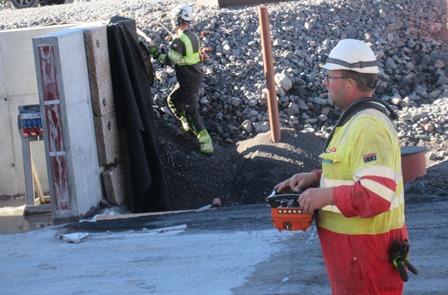We were watching LKAB move one of Kiruna’s old buildings to a new place, away from the collapsing ground of town. As the house trundled down the road – our brains having trouble accepting what we saw, though we knew it to be true, I thought – you couldn’t find a better image for the speed of change in Kiruna. One day you might have three neighbours, and the next you might have four, five or six, houses moving into your neighbourhood literally overnight. Nothing can be relied on to stay where it is.
The house being moved had several ‘LKAB’ signs hung on it, it not being a strange thing, apparently, for a commercial company to boast about the fact that it’s deciding where a town’s buildings should be. The signs appeared the night before its move, like an instruction at the foot of a bed on a hospital ward the night before an operation. It’s hard not to imagine the house has feelings, wondering what will happen.
There are only a few small huddles of people around. Quite a few of Kiruna’s historic buildings have already moved so people have had plenty of opportunities to watch this before, but it’s the first time for us. LKAB personnel in high viz jackets gather around the scene, heading off any traffic, keeping any eye out for sudden obstacles.
The house is driven by a man with a small orange box hanging from his neck, like an old-fashioned icecream seller at the cinema, walking behind or in front of the towering trailer. When he fiddles with a small knob on the box the entire structure moves half a metre to the right or left, the many-wheeled trailer able to turn almost on a pin. Drones buzz overhead passing images to people beneath. Moving from its resting place for the last 100 years, the house slowly takes the sharp corner out onto the main road. The man with the orange box looks calm, but one wonders how it feels to drive a house. You could imagine he is quite enjoying himself. He looks like he’s been playing video games like this all his life. Moving houses on trailers might be his dream job.
The house is one of several residential old wooden buildings erected around 1910 by the railway company for their workers. For 100 years it has been here in view of the tracks at the edge of town, tracks which are no longer in use because the station was forced to move further out of town. Now the house is being moved further out, back within sight of the railway. After ten minutes on the road, moving at a fast walking pace, the house arrives at the station. The station clock says 11.08 as it pulls in. It’s not often you see a house arriving at a station platform.

Someone with a pushchair looks impatient with the house and its entourage. At first I mistake her for someone wanting a good view, but then as we come level with side access to some houses she peels off hurriedly down the road. (‘Sorry I’m a bit late, I got held up by a very slow house’).
Soon after the station the house turns into the site prepared for it – a row of three new foundations for three identical buildings. This, the first house of the three, has to be driven with extreme care over the other two foundations before it reaches its own. We have found a place to watch, the other side of a wire fence, and can see how closely the house glides over the concrete blocks. People are closer up still, watching it as it passes, ready to shout halt if someone has made a potentially disastrous failure in any of the measurements. We are holding our breath as it passes over the first, then second set of foundations.
At its final destination it comes to a halt, hanging over the foundations. The man with orange box moves from one side to the other, checking and adjusting, and others appear with wooden rulers and digital measuring devices at each of the corners. Eventually the man with the orange box lights a cigarette. We take this to be a good sign.

There is a short pause – we’re all waiting, and we’re not sure what for. Mysteriously, small bits of wood are placed under each of the metal girders. Then the man twiddles a knob to lower the house the final couple of centimetres. All that impressive engineering and then, finally, the house comes to rest on some uneven, carelessly placed old bits of wood. It takes a while to realise that it will slowly settle onto these, compressing and cracking them until it’s in it’s preferred position. You can only take a house so far – in the end it decides how it will lie there.
The workers retire for a coffee break, and the few of us still watching begin to wander off. A man with a bicycle approaches us and we exchange views on how interesting we found the whole process. We ask him where he lives, and learn he is a visitor, from Växjö in the south of the country. He sets off on the bike, but then he returns, unsure of the best way to go, and asks us where the cycle path to town is. We shrug our shoulders, no idea. ‘Do you live in Kiruna?’, he asks, rather pointedly. As if, if we did, then we jolly well ought to know where the path is. We do live here, but no, we don’t know where the cycle path is.
He’s from Växjö and in his world a cycle path is made in 1982 and is still in the same place in 2022. He is irritated by our ignorance, irritated that it isn’t clear where the path is. He looks at us as if we’re idiots, and cycles off in the dusty wake of the now empty, many-wheeled trailer and its LKAB entourage. It can be hard to explain what it’s like to live in Kiruna these days.

